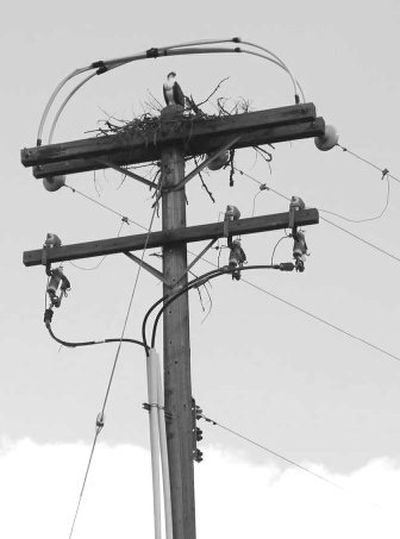CRITTER WATCH: Power to the ospreys
‘Fish hawks’ like Avista poles

“For a couple of years, an osprey pair has been nesting on this pole between the old and new Highway 395s at Dartford, where a zillion cars go by each day,” wrote North Side resident Tom Frost as he e-mailed the accompanying photo to Critter Watch.
“Last winter after nesting season the nest was blown off the pole, and the power company put up the yellow plastic poles designed to discourage bird nesting, which obviously worked great. They’re back, and hard at work on a new nest.
“Maybe the birds could drape a sheet over the frame to keep the chicks shaded when it’s hot?”
Robin Bekkedahl, Avista Utilities environmental coordinator, confirmed the yellow wands are an inexpensive but often futile attempt to discourage nesting on power poles.
Most of the time, Avista builds a more secure nesting platform nearby and relocates the nest with an 87 percent success rate, said Hugh Imhof, company spokesman.
But ospreys are flourishing in this land of lakes and rivers, and the utility is running out of suitable places to put up separate nesting poles, Bekkedahl said, noting that “Some landowners won’t let us put up new poles.”
Moving a nest to a platform costs about $2,000, she said: “We’ve already moved five of them in the Spokane (and North Idaho) area this year.”
Regarding the Dartford ospreys, Imhof said, “We’ll let them nest this year, and then we’ll try to relocate the nest.”
Two main factors: The power pole serves a sewage treatment facility, and the nest is in a high traffic area. If it blows out again, somebody could be hurt.
And it’s not a safe place for chicks to fledge.